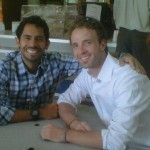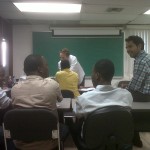In my last post I alluded to some of the business ideas that our students had. Today I want to highlight a couple of the ideas.
Let me first preface this by saying that there is a lot of opportunity to do things here in Haiti. Much of the basic infrastructure we expect in the States, such as roads and our “always on” power grid, are either missing or very broken in Haiti. Of course people being people, many workarounds have been found (such as buying SUVs to drive in the city) and some newer technologies have come in to take the place of what’s existent (such as solar installations).
Many of these ideas require lots of capital which is something that our entrepreneurs are generally in short supply of. This means that their businesses need to be VERY compelling, or have plans to start small and scale. Even then funding can be difficult. To get a competitive rate loan from a bank in Haiti you need to be officially registered (usually as a Sole Proprietorship) and you have to already be running the business so as to show at least 1 quarter’s of financial statements (or be an individual with a track record of successful business or come from a family with money or a track record). Of course you could always take out a micro-finance loan but who wants to pay rates in excess of 40% per year on a $2000 loan? Not me and not our businesses. So we have your traditional network of family/friends to beg money from or this bank loan process. Thankfully EGI (our NGO host) has plans in the works to setup an investment fund but for now these are the options. As you can imagine, you can’t start many capital-intensive operations when you need 3 months of real statements to get it off the ground. With that in mind, let’s look at two of our entrepreneurs.
First up for the examples is Paul. Paul is already running a small-scale enterprise from his home and wants to expand (we’ve noticed that our “best” students are generally of this same vein). He has an extra room and wants to do something that will not only be profitable for him but also help his countrymen by building some valuable computer skills to high school students. A true “win-win” (sorry Professor Tenbrunsel). To do so he’ll need 20 computers, a screen, some teaching materials, and various furniture pieces. Adding it all up he’s looking at about $5,000 to get this off the ground. As part of the training we’ve given instruction on doing market research and putting together pro-forma financial statements. Paul is a professional accountant so he knew much of this but he’s done a great job with his market research, determining how many schools are around him, determining the tuition, and talking with the principles to build relationships for not only his existing business but this new venture as well. He’s built 3 different versions of his pro-formas for different numbers of classes and is doing a sensitivity analysis for price. All in all he’s on his way and the investment amount is reasonable, especially since he has some money he can put into it. He can choose to start small with smaller classes and scale or start in just one building and then grow to have multiple locations.
Our second example is Illioto who often misses or falls asleep in class because in addition to taking our class he’s doing his residency for pediatric surgery. His idea is to create a clinic and an affordable insurance to enable uninsured children/students (2-14) to have access to medical care. His idea is grand: a hospital capable of servicing 200 children at a time with 50+ doctors, 75+ nurses, etc… for a target market of 300,000 children in the Port Au Prince area. This won’t come cheap either at $275,000. However he has an idea to solicit funds from the doctors for the clinic such that they would draw a smaller salary but be equity owners of the clinic. Since doctors make reasonable money here in Haiti it’s reasonable to think that he could get the $5,500 per person needed to launch this. Again, this model is replicable and allows him to expand to other locations. While he still has a lot of work to do in order to determine the costs of such an operation, we like this innovative funding model a lot.
So we have two ideas of vastly different scale but with the potential to find the necessary capital and to also expand outside of the initial idea. Each has the potential to benefit both the entrepreneur and the country at large. In fact all of the students are pursuing ideas to that end. It’s just part of the EGI ethos.

